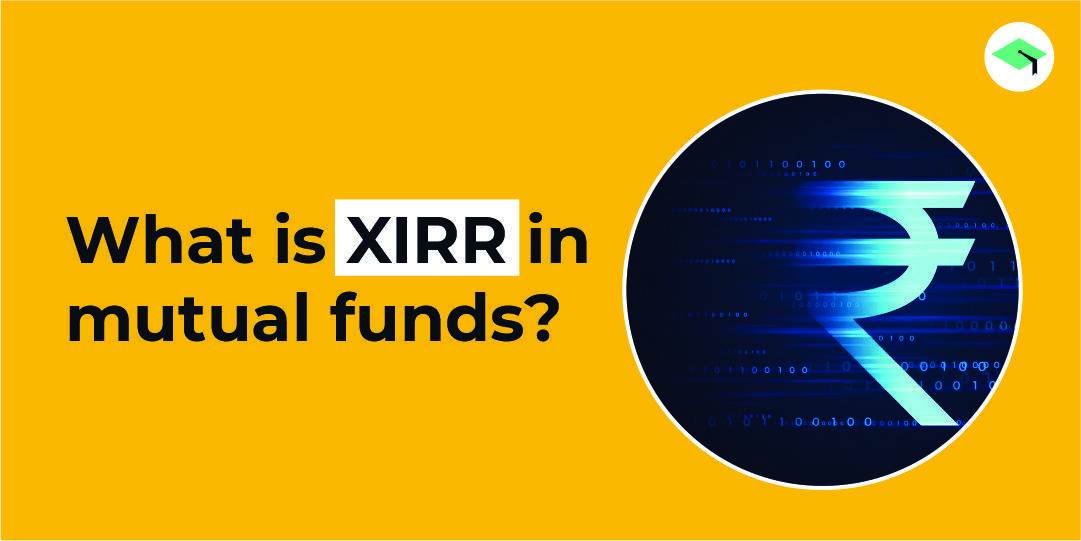Maximize Your Returns: Exploring XIRR in Mutual Funds

What is XIRR in mutual funds? Why do you need to understand it? Let’s find out. Whenever you invest in real estate, stocks, mutual funds, etc., you usually measure the returns by calculating the value of your total principal investment.
For instance, let’s assume that you have invested INR 10 lakhs in a mutual fund scheme. Over a specific time period, it doubles and gives you INR 20 lakhs.
However, there are certain intricacies you should be aware of. The investor of a mutual fund scheme should know the time duration in which their investments doubled.
For instance, it is extremely worrying for investors if their funds double in 50 years.
Hence, the duration in which the investment doubles is a crucial factor. The two integral components of any mutual fund scheme are the Compound Annual Growth Rate (CAGR) and the Extended Internal Rate of Return (XIRR).
So, if you are eager to invest in mutual funds, it’s important for you to know about XIRR in mutual funds. Here are some significant points you should know about XIRR.
Overview of XIRR in mutual fund schemes
XIRR is a single rate of return that provides the current value of the entire investment when applied to each SIP. XIRR is your actual return on investment.
It is a tool for calculating returns where many transactions happen at different times.
Usually, there are a series of investments in a SIP. At times, one can redeem a small amount from their investments. On the other hand, investors can pause several months of investments. In such instances calculating the returns become easier with XIRR.
The necessity of XIRR in mutual funds
Investment cash flows are dynamic. In other words, they are never evenly spaced out. It is standard for an investment scheme to have early withdrawals or late deposits. Investors can skip a couple of months of installments.
In these conditions, calculating the return from your investment scheme becomes difficult. However, with XIRR, you can easily calculate your returns.
Fortunately, you can use the XIRR formula in Excel to calculate uneven cash flow intervals.
In case you don’t know, XIRR is the modification over the internal rate of return (IRR). It has additional flexibility as XIRR can assign dates to individuals’ cash flows in your portfolio.
Why does XIRR make sense in mutual funds schemes?
If you invest INR 4000, INR 9000, INR 4000, and INR 6500 in SIPs over the last five years and get INR 53000, your return is 22%. In most cases, the IRR is the resultant amount.
With this concept, you can conclude how much you’ve earned from your investments. But in most modern-day mutual funds, the cash flow is not evenly distributed.
Mutual funds are popular among investors as they allow them to invest and redeem at regular intervals. In other words, when the cash flows are distributed over a period, XIRR is an excellent feature to measure the returns.
Moreover, if you are investing in mutual funds via a systematic investment plan (SIP) or redeeming via a systematic withdrawal plan (SWP), it is crucial to know about XIRR.
XIRR will handle all these inconsistent cash flows. Furthermore, it can offer you clear insights into the status of your investments in mutual funds.

How can you derive XIRR in Excel?
Here is the step-by-step process of calculating XIRR for your mutual funds in MS Excel.
- Enter all your SIPs or transactions in one column in negative. Wherever there is an interest inflow, show it as a positive figure. The additional lump sum amount should be entered as negative again.
- In the corresponding column, add the date of the transaction.
- In the last row, mention the current value of your portfolio in mutual funds. You should also input the correct date.
- Now you can use the XIRR function (in Excel). XIRR usually contains values, dates, etc.
- You should choose values for a series of cash flows that relate to payments based on dates. The column made separately for the date is applicable. Input the values accordingly. Note that the guessing parameter is optional.
Use of CAGR
Most investors inquire whether they can use CAGR to calculate their returns. When we want to invest in a mutual fund, we usually check its returns over the past three or five years.
These returns are typically point-to-point returns. In lots of mutual funds, investors use CAGR to calculate returns. However, if you have personal investments in mutual funds, it is worthwhile to rely on XIRR.
As you can see, XIRR is the most appropriate way to know the investment returns. While CAGR helps you to select mutual funds properly, XIRR is essential to assess the returns you get from your investments in mutual funds.
In other words, when you have a series of investments over time, always rely on XIRR. XIRR is probably the best method to calculate returns for your mutual fund.
Importance of XIRR in Mutual Funds
For calculating returns of a Systematic Investment Plan (SIP) in a mutual fund, XIRR is used. XIRR considers period investment made over time and then adjusts for the time value.
You can calculate XIRR using Microsoft Excel by using the XIRR formula to arrive at a particular value. The formula is = XIRR (value, dates, guess).
Let us see the example and interpretation –
- SIP amount = Rs. 5,000
- SIP investment dates: Start – 1 January 2022
- Date of redemption: 01 July 2022
- Maturity sum = Rs. 31453.34
Let’s assume cash flows as mentioned in the table below:
| 01-01-2022 | -5000.00 |
| 01-02-2022 | -5000.00 |
| 01-03-2022 | -5000.00 |
| 01-04-2022 | -5000.00 |
| 01-05-2022 | -5000.00 |
| 01-06-2022 | -5000.00 |
| 01-07-2022 | 31453.34 |
| XIRR | 17.62% |
What is a good XIRR in mutual funds?
It is difficult to tell which XIRR is good as it is subjective to every individual, their objective, investment time horizon, investment process, investment philosophy, investment instruments, and risk appetite.
Generally, for equity mutual funds – an XIRR over 12% is considered good and for debt mutual funds anything above 7.5% is considered good.

Top 10 SIP in Mutual Funds
Difference between CAGR and XIRR?
| XIRR | CAGR |
| Average annualized return. | Absolute annualized return. |
| Takes into account cash inflow and outflow | Uses the invested amount, redemption amount, and time period. |
| Best for SIP investment return evaluation | Best for lumpsum investment return evaluation |
| Adjusts for the time value of money. | Does not adjust for the time value |
FAQs
What is XIRR in mutual funds?
XIRR is a single rate of return that provides the current value of the entire investment when applied to each SIP. XIRR is your actual return on investment.
It is a tool for calculating returns where many transactions happen at different times.
What is a good XIRR in Mutual Funds?
A good XIRR is subjective and depends on the type of mutual fund you have invested in. Generally speaking, an XIRR over 12% is considered good and for debt mutual funds anything above 7.5% is considered good.
What is the XIRR formula?
You can calculate XIRR using Microsoft Excel by using the XIRR formula to arrive at a particular value. The formula is = XIRR (value, dates, guess).
Is XIRR a good measure?
XIRR helps you calculate returns over a considerable period of time. It is a good way to calculate returns on investments whenever there are multiple transactions taking place at different times.
What is XIRR in mutual funds?
XIRR, short for Extended Internal Rate of Return, is a calculation method used to determine the returns on investments in mutual funds where there are multiple transactions occurring at different times. It provides a single rate of return that reflects the current value of the entire investment when applied to each systematic investment plan (SIP). XIRR is particularly useful when calculating returns for investments spanning over a year and involving various transactions.
Why is XIRR important in mutual funds?
XIRR plays a vital role in mutual funds as it enables investors to calculate the returns on their investments made through SIP and other irregular intervals. Unlike other metrics like Compound Annual Growth Rate (CAGR) or point-to-point returns, XIRR provides a more accurate measure of returns, especially when multiple cash flows are involved. It considers the timings of both investments and withdrawals, making it a comprehensive way to calculate consolidated returns.
How is XIRR calculated in mutual funds?
To calculate XIRR in mutual funds, it is necessary to input all cash outflows, such as SIP installments and lump sum purchases, as negative values (with a minus sign) and all cash inflows, including SWP, dividends, and redemptions, as positive values. If there are remaining units yet to be redeemed, the current investment value should be included along with the date of the Net Asset Value (NAV) to accurately calculate the XIRR of the mutual fund investment. Microsoft Excel offers an inbuilt function that simplifies the calculation of XIRR.
Consult an expert advisor to get the right plan for you
recommended reading














